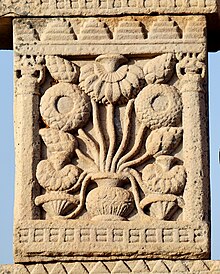Kalasha

A kalasha, also called Pūrṇa-Kalaśa, Pūrṇa-Kumbha, Pūrṇa-Ghaṭa, also called ghat or ghot or kumbh (
Sometimes "kalasha" also refers to such a pot filled with water and topped with a coronet of mango leaves and a coconut. This combination is often used in Hindu rites and depicted in Hindu iconography. The entire arrangement is called Purna-Kalasha (पूर्णकलश), Purna-Kumbha (पूर्णकुम्भ), or Purna-ghata (पूर्णघट). Each of these names literally means "full or complete vessel" when the pot is referred to as the Kalasha (to avoid confusion, this article will refer to the pot as Kalasha and the entire arrangement as Purna-Kalasha).
Sometimes the Kalasha is filled with coins, grain, gems, gold, or a combination of these items instead of water. The coronet of 5, 7, or 11 mango leaves is placed such that the tips of the leaves touch water in the Kalasha. The coconut is sometimes wrapped with a red cloth and red thread; the top of the coconut (called Shira – literally "head") is kept uncovered. A sacred thread is tied around the metal pot. The Shira is kept facing the sky.
The Kalasha is viewed as an auspicious object in
In Hinduism


The Purna-Kalasha is considered a symbol of abundance and "source of life" in the
The Kalasha is believed to contain amrita, the elixir of life, and thus is viewed as a symbol of abundance, wisdom, and immortality. The Kalasha is often seen in Hindu iconography as an attribute, in the hands of Hindu deities like the creator god Brahma, the destroyer god Shiva as a teacher, and the goddess of prosperity Lakshmi.[7]
The Purna-Kalasha is believed to be a symbol of auspiciousness embodying either
Sometimes, a silver or brass face of the Goddess is attached over the coconut of the Purna-Kalasha. In this form, the Purna-Kalasha symbolizes the Goddess as the manifestation of mother earth with her water, minerals, and vegetation. This method of Kalash pooja (worship) has come in for Vishnu in household functions too.[9]
The Purna-Kalasha is also worshipped at Hindu ceremonies like Griha Pravesha (house warming), child naming,
Other interpretations of the Purna-Kalasha associate with the five
A kalash is placed with due rituals on all important occasions. It is placed near the entrance as a sign of welcome.


In Jainism
The Kalasha is a symbol of the nineteenth
Buddhism
The Pūrṇakumbha refers to “full vessel” or "auspicious abundance" in Buddhism. It is used as flower offering to Buddha and Bodhisattvas at prayer alters, as well as representing treasure of wisdom. Purnakumbha represents health, longevity, wealth, prosperity, wisdom and symbolizes the Buddha's infinite quality of teaching the dharma.[13] Japanese art of Ikebana emerged from this Buddhist floral offering tradition.[14]
In heraldry
A variant of the Kalasha called Purna Kumbha or Purna Ghataka from Amaravati archaeological site is part of the official state emblem of Andhra Pradesh state in India.[15][16]
See also
References

- ^ Cologne Digital Sanskrit Dictionaries: Monier-Williams Sanskrit-English Dictionary Padmotpalakumudvat (पद्मोत्पलकुमुद्वत्):— [=padmotpala-kumud-vat] [from padma] mfn. furnished with the lotus flowers called Padma, Utpala and Kumuda, [Bhāgavata-purāṇa]
- ISBN 978-81-900002-8-4.
- ISBN 978-81-900002-8-4.
- ISBN 0-85229-760-2
- ^ Uesugi, Akinori; Oya, Hiroshi; Peter, Jenee (2020). "Roof Tiles in Ancient South Asia: Its Developments and Significance". Center for Cultural Resource Studies, Kanazawa University, Kakuma-machi, Kanazawa, Ishikawa.
- ISBN 81-7387-030-6p. 171 "Drona Parva, 11, 29"
- ^ The Book of Hindu Imagery: Gods, Manifestations and Their Meaning by Eva Rudy Jansen
- ISBN 0-89281-807-7
- ISBN 1-59682-117-5
- ^ India: Known Things, Unknown Secrets by R. Venugopalan pp.130-132 Published 2004
B. Jain Publishers 290 pages ISBN 81-8056-373-1
- ISBN 978-81-900002-8-4.
- ISBN 81-208-1534-3
- ISBN 978-951-609-377-5.
- ^ "History of Ikebana | IKENOBO ORIGIN OF IKEBANA". www.ikenobo.jp.
With the introduction of Buddhism to Japan in the 6th century, the custom of offering flowers on the Buddhist altar became common. As indicated by the use of the Chinese character meaning "flower" is the names of sutras such as the "Kegon-kyo (Avatamsaka Sutra)" and "Hokke-kyo (Lotus Sutra)," from the beginning flowers have been deeply related to Buddhism. Lotus is widely found in India where Buddhism originated, and it is a representative flower for Buddhist offerings. In Japan, however, other suitable flowers for each season were selected for this purpose. Among various ways of Buddhist offering, placing Mitsugusoku, a set of three ceremonial objects - flower vase, incense burner and candle holder – became popular in the Kamarura and Nanbokucho periods.
- ^ "Coat of Arms- Emblem of Government of Andhra Pradesh" (PDF). Government of Andhra Pradesh. 2018-11-14. Retrieved 2023-06-16.
- ^ "About General Administration Department (Links for emblem and other state symbols)". Government of Andhra Pradesh. Retrieved 2023-06-16.
